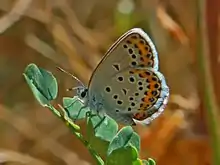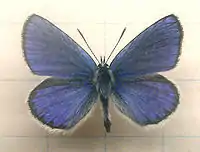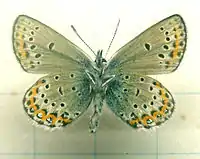Plebejus idas
Plebejus idas, the Idas blue or northern blue,[1] is a butterfly of the family Lycaenidae.
| Plebejus idas | |
|---|---|
.jpg.webp) | |
| Plebejus idas. Male, upperside | |
 | |
| Plebejus idas. Female, underside | |
| Scientific classification | |
| Kingdom: | Animalia |
| Phylum: | Arthropoda |
| Class: | Insecta |
| Order: | Lepidoptera |
| Family: | Lycaenidae |
| Genus: | Plebejus |
| Species: | P. idas |
| Binomial name | |
| Plebejus idas (Linnaeus, 1761) | |
| Synonyms | |
| |
Subspecies
Subspecies include the following:[2]
- Plebejus idas acreon (Fabricius, 1787)
- Plebejus idas alaskensis F. Chermock, 1945
- Plebejus idas altarmenus (Forster, 1936)
- Plebejus idas argulus (Frey, 1882)
- Plebejus idas aster (Edwards, 1882)
- Plebejus idas atrapraetextus Field, 1939
- Plebejus idas bavarica (Forster, 1936)
- Plebejus idas bellieri (Oberthür, 1910)
- Plebejus idas empetri Freeman, 1938
- Plebejus idas longinus (Nabokov, 1949)
- Plebejus idas lotis Lintner, 1879
- Plebejus idas magnagraeta Verity,1936
- Plebejus idas nabokovi (Masters, 1972)
- Plebejus idas sareptensis Chapman, 1917
- Plebejus idas scudderi (Edwards, 1861)
- Plebejus idas sublivens (Nabokov, 1949)
- Plebejus idas tshimganus (Forster, 1936)
Plebejus itas lotis (syn. Lycaeides idas lotis, Lycaeides argyrognomon lotis) is a critically endangered subspecies native to Mendocino County, California,[3] with sightings in Sonoma and Marin counties. It has been listed as an endangered species since June 1, 1976,[4] but has not been sighted in the wild since 1994.
Distribution
This species can be found in most of Europe (except parts of Spain, southern Italy and the United Kingdom),[5] in the northern regions of the Palearctic (Siberia, mountains of South Siberia and Yakutia) and in the Nearctic realms.[6][2]
Habitat
It usually inhabits grassy flowery areas, mixed evergreen forests and wet meadows up to alpine levels,[5][7] at an elevation of 200–2,100 metres (660–6,890 ft) above sea level.[8]
Description
Plebejus idas has a wingspan of 17–28 mm.[1][8] This species is quite variable in colors and markings. The upperside of male's wings is iridescent blue, while it is brown with orange submarginal spots in the females. The underface of the wings is greyish with black spots and it shows a thin black line and small dots along outer margin. Along these margins are also present a rather large orange band with blue spots.[7]
This species is very similar to the Silver studded blue (Plebejus argus) and to the Reverdin's blue (Plebejus argyrognomon).[5] The forelegs of male of Plebejus idas lacks a hook which is present in Plebejus argus.[8]
Biology
The species flies in a single brood from June to August depending on location.[7] The larvae feed on Calluna vulgaris, Vaccinium uliginosum, Empetrum nigrum and various Fabaceae species (mainly Cercis siliquastrum, Melilotus albus, Lotus corniculatus, Cytisus, Genista tinctoria, Trifolium pratense, Chrysaspis campestris, Astragalus alpinus and Anthyllis). They are usually attended by ants (Lasius and Formica species).[2][9] Second-stage of the caterpillars overwinter.[7]
Gallery
References
- Northern Blue, Butterflies of Canada
- Funet
- "Lotis Blue Butterfly", Arcata Fish and Wildlife Office
- "Lotis Blue Butterfly" Archived 2014-06-05 at the Wayback Machine, Xerxes society Profile
- Matt Rowlings European Butterflies
- Jim P. Brock, Kenn Kaufman (2003) Kaufman Field Guide to Butterflies of North America. Boston: Houghton Mifflin. ISBN 0-618-15312-8
- Butterflies and Moths of North America
- Simon Coombes Captain's European Butterfly Guide
- Paolo Mazzei, Daniel Morel, Raniero Panfili Moths and Butterflies of Europe and North Africa
External links
| Wikimedia Commons has media related to Plebejus idas. |
| Wikispecies has information related to Plebejus idas. |
.jpg.webp)
.jpg.webp)


_female_Bulgaria.jpg.webp)
_female_underside_Bulgaria.jpg.webp)
